The Seagate 600 & 600 Pro SSD Review
by Anand Lal Shimpi on May 7, 2013 8:00 AM ESTRandom Read/Write Speed
The four corners of SSD performance are as follows: random read, random write, sequential read and sequential write speed. Random accesses are generally small in size, while sequential accesses tend to be larger and thus we have the four Iometer tests we use in all of our reviews.
Our first test writes 4KB in a completely random pattern over an 8GB space of the drive to simulate the sort of random access that you'd see on an OS drive (even this is more stressful than a normal desktop user would see). I perform three concurrent IOs and run the test for 3 minutes. The results reported are in average MB/s over the entire time. We use both standard pseudo randomly generated data for each write as well as fully random data to show you both the maximum and minimum performance offered by SandForce based drives in these tests. The average performance of SF drives will likely be somewhere in between the two values for each drive you see in the graphs. For an understanding of why this matters, read our original SandForce article.
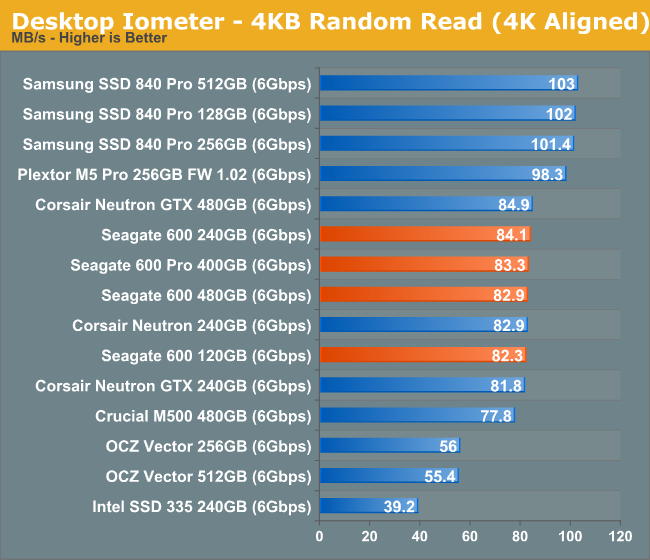
Random read performance is consistent across all capacity points. Performance here isn't as high as what Samsung is capable of achieving but it is very good.
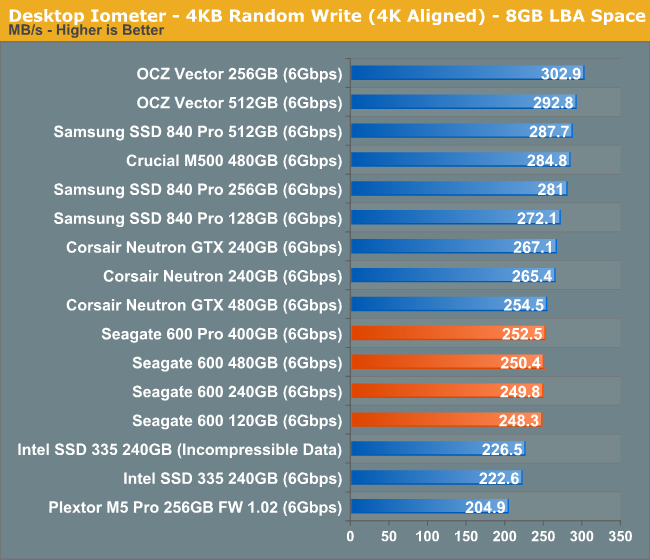
Low queue depth random write performance has just gotten insanely high on client drives over the past couple of years. Seagate doesn't lead the pack with the 600 but it does good enough. Note the lack of any real difference between the capacities in terms of performance.
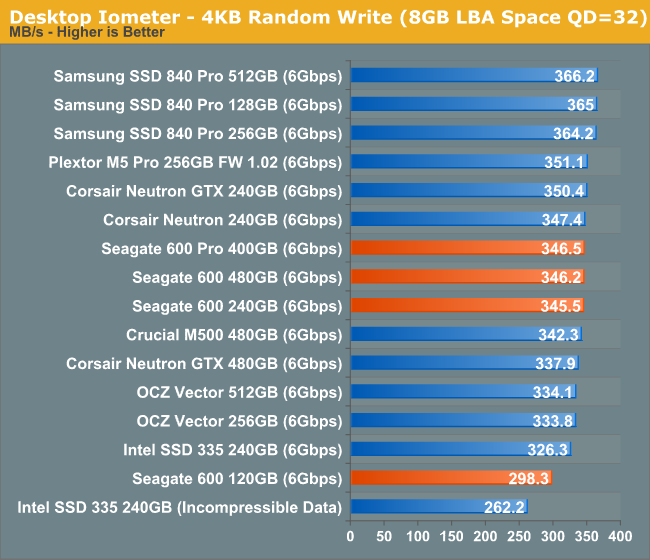
Ramp up queue depth and we see a small gap between the 120GB capacity and the rest. The 600/600 Pro climb the charts a bit at higher queue depths. Note the lack of any performance difference between the 600 and 600 Pro at similar capacities.
Sequential Read/Write Speed
To measure sequential performance I ran a 1 minute long 128KB sequential test over the entire span of the drive at a queue depth of 1. The results reported are in average MB/s over the entire test length.
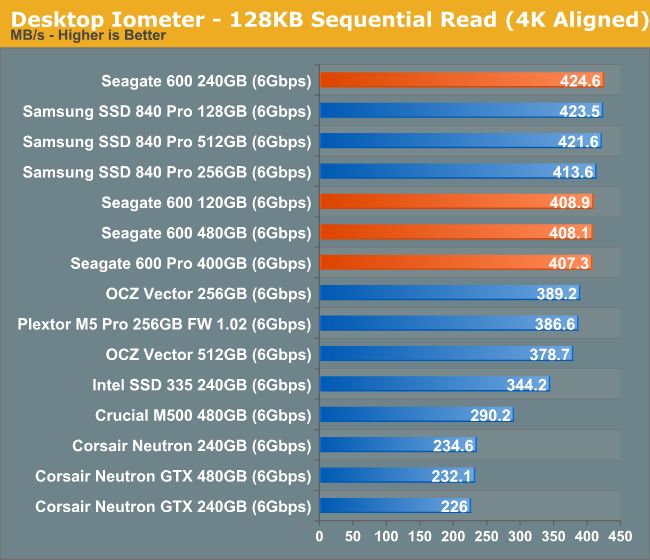
Here's how you tell that Seagate has client drive experience: incredible low queue depth sequential read performance. I'm not sure why the 240GB 600 does so well here, but for the most part all of the drives are clustered around the same values.

Low queue depth sequential writes are also good. The 240GB capacity does better than the rest for some reason. Only the 120GB capacity shows any sign of weakness compared to other class leaders.
AS-SSD Incompressible Sequential Read/Write Performance
The AS-SSD sequential benchmark uses incompressible data for all of its transfers. The result is a pretty big reduction in sequential write speed on SandForce based controllers.
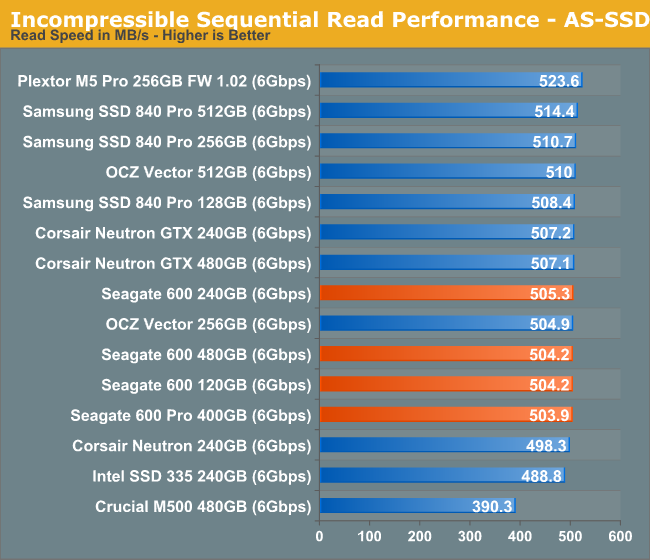
On the read side, at high queue depths we're pretty much saturating 6Gbps SATA at this point. The fastest drive here only holds a 3% advantage over the 600s.
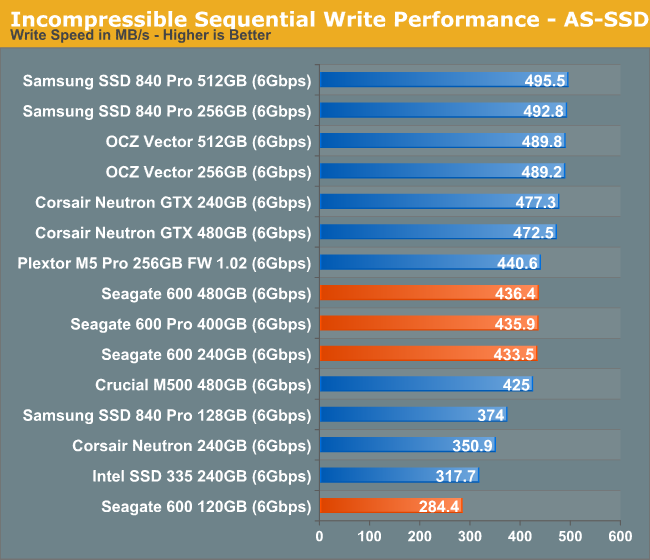
Once again we see solid performance from the 600s. There's no performance advantage to the Pro, and the 120GB capacity is measurably slower.










59 Comments
View All Comments
StealthGhost - Wednesday, May 8, 2013 - link
To me it was always just that HDDs are vastly different than SSDs. Making SSDs when you make HDDs is like starting from scratch almost. That is why the most random companies are making SSDs, because they made flash storage before. Corsair, OCZ, Crucial harddrives? I've owned RAM from all 3 but never a harddrive, but it makes sense for them to side step over from RAM to SSD, not so much for WD to go all the way down and then back up over to SSD.I hope WD becomes a big name in SSDs though, I have 5 WD harddrives that I can think of off the top of my head and one is from 2003. As you can tell, they're my favorite HDD manufacturer.
phillyry - Sunday, May 12, 2013 - link
Cactusdog, "I don't understand why Seagate and WD were so slow in the SSD market."Because they didn't want to destroy their reputations with a the shenanigans that was going on in the first couple gens of SSDs. They wisely waited until the tech was mature so that their multibillion dollar reputations wouldn't go down the drain.
Tams80 - Tuesday, May 7, 2013 - link
Same. I think around 500GB is the minimum I'd prepared to go with (for a laptop/mobile computer). They are still a bit too pricey and from my experience the hybrid drives, while good, aren't really worth it. 1TB would be great, but that will probably require waiting a few years.The 840 Pro looks to still be the best, but yes, it's still far too expensive for me. =(
klmccaughey - Tuesday, May 7, 2013 - link
The 240GB non Pro 840 is pretty good unless you are doing a lot of writing - very well priced.I have a 2TB HD and a 256GB Steam drive. With Steam Tool / or caching software that is plenty. My C drive is 2 x 128GB Vertex 3's in Raid 0.
Don't wait to switch! Just get what you can and add more when you can - you will never look back :)
MrSpadge - Tuesday, May 7, 2013 - link
Yeah.. just make smart use of the space you've got and you should be able to get by with much smaller SSDs than 500 GB. Personally using 64 GB to cache my 3 TB HDD - fast enough for me :)phillyry - Sunday, May 12, 2013 - link
The OP is talking about a mobile computer (laptop), not a desktop solution where you can have additional hard drives.creed3020 - Tuesday, May 7, 2013 - link
Seagate may be late to the game but wow what an entrance! Going with the LM87800 almost guaranteed a strong performer as we already know from the Corsair Neutron's history. Their own special sauce added to the firmware shows that they are taking this market seriously.The HDD manufacturers, glorious duopoly and all, need to see the writing on the wall and get some products into this market vertical. There will be a need for spinning platters for years to come still as 4TB SSDs are still a good ways out.
I'm currently on the fence for a Samsung 840 500GB but this announcement I need to wait and see how the reliability on these drives pans out as this may be the better choice.
Oxford Guy - Wednesday, May 8, 2013 - link
MLC drives are generally going to be more reliable than TLC drives, unless you're dealing with firmware bugs (like the horribly buggy 1st generation Sandforce controller in the Vertex 2e)name99 - Wednesday, May 8, 2013 - link
"Seagate may be late to the game but wow what an entrance!"To me this is in the interesting point. Presumably Seagate are interested in surviving for more than the next five years. Which means they have to be in the broadly defined storage business, not just the HD business. Which in turn means: raises the question --- presumably they want to be the equivalent in the flash business of their role in the HD business?
What would that take? If they were doing it seriously, it would take
(a) own the controller. It seems they already own the firmware. Perhaps they don't care much about the LAMD/Hynix link because the next step is to design their own controller?
(b) fab the flash. Until they do that, as has been said, they're just one of a dozen assemblers. Of course fabbing flash is not a completely trivial business to get into... So --- buy Hynix (or someone else)? Or not the whole company, but at least the flash division? I suspect we will see something like this.
If they DO own the firmware, the chip, and the flash, they are at least in a rather better position.
They can start to apply real engineering to these devices in a way we haven't yet seen, most obviously in much better power performance, both idle power and peak random writes power. There may also be scope for other innovations once you own the entire pipeline, for example you can tweak the flash being fabbed for a more precise set of specs, or you can drive it to tend to certain (known) failure modes which your firmware is set up to work around.
JellyRoll - Tuesday, May 7, 2013 - link
Corsair recently released new versions of the Neutrons with a die shrink, are these Neutrons compared in the article with the new NAND?